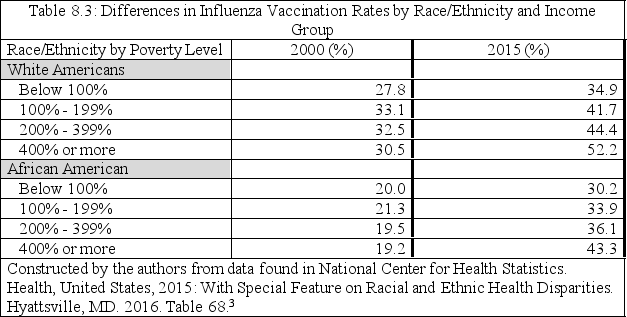Deck 8: Using Physicianpatient Partnerships to Reduce Health Care Disparities
Question
Question
Question
Question
Question
Question
Question
Question
Question
Question
Question
Question
Question
Question
Question
Question
Question
Question
Question
Question
Question
Question
Question
Question
Question

Unlock Deck
Sign up to unlock the cards in this deck!
Unlock Deck
Unlock Deck
1/25
Play
Full screen (f)
Deck 8: Using Physicianpatient Partnerships to Reduce Health Care Disparities
1
Physician/patient partnerships can be inferred to mean situations in which:
A) Physicians advise patients of their role in preventing and/or successfully treating illness and disease and patients act on that advice.
B) Patients remind physicians of services needed to support their wellness or healing and physicians appraise their recommendations
C) Patients are determined to do all that they can do to support their own health
D) a, b and c
E) None of the above
A) Physicians advise patients of their role in preventing and/or successfully treating illness and disease and patients act on that advice.
B) Patients remind physicians of services needed to support their wellness or healing and physicians appraise their recommendations
C) Patients are determined to do all that they can do to support their own health
D) a, b and c
E) None of the above
D
2
The concept of physician/patient partnerships is a strategy for reducing health disparities implicitly acknowledges that: (Level3)
A) Healthcare outcomes occur as a result of the interaction of the patient's and the physician's behavior within the context of the other elements that shape the patient's determinants of health and the physician's determinants of quality of care.
B) Suggests that maximal patient healthcare occurs as the product of the physician and the patient
C) a and b
D) b and c
E) a, b, and c
F) None of the above
A) Healthcare outcomes occur as a result of the interaction of the patient's and the physician's behavior within the context of the other elements that shape the patient's determinants of health and the physician's determinants of quality of care.
B) Suggests that maximal patient healthcare occurs as the product of the physician and the patient
C) a and b
D) b and c
E) a, b, and c
F) None of the above
C
3
One way in which a patient can partner with their physician is to respect their physician by always allowing the physician to offer preventive services.
True
4
The "case study" of the impact of physician/patient partnership leading to a reduction in disparities that was discussed in the text was influenza vaccinations. Based upon your own analysis, which factor of factors listed below would lead the authors to use this health measure as an example of physician/patient partnership".
A) Influenza vaccinations are not required. Therefore, both the patient and the physician play a role in their use as a preventive measure.
B) Like other vaccinations, influenza vaccinations are required by law. The physician partner informs the patient of this fact and the patient complies.
C) Both a and b
D) Neither a nor b
A) Influenza vaccinations are not required. Therefore, both the patient and the physician play a role in their use as a preventive measure.
B) Like other vaccinations, influenza vaccinations are required by law. The physician partner informs the patient of this fact and the patient complies.
C) Both a and b
D) Neither a nor b

Unlock Deck
Unlock for access to all 25 flashcards in this deck.
Unlock Deck
k this deck
5
Questions require review of Table 8.1 below.

-In the year 2000, based on your calculations using the data in Table 8.1., Asian Americans received influenza vaccines at a rate that was ___% as high as their Caucasian counterparts.
A) 89.7%
B) 11.5%
C) 70.1%
D) 52.1%
E) None of the above

-In the year 2000, based on your calculations using the data in Table 8.1., Asian Americans received influenza vaccines at a rate that was ___% as high as their Caucasian counterparts.
A) 89.7%
B) 11.5%
C) 70.1%
D) 52.1%
E) None of the above

Unlock Deck
Unlock for access to all 25 flashcards in this deck.
Unlock Deck
k this deck
6
Questions require review of Table 8.1 below.

-In the year 2000, White Americans had a vaccination rate that was __% higher than Latinos:
A) 170.1%
B) 70.1%
C) 58.8%
D) 81.2%
E) 117.7%

-In the year 2000, White Americans had a vaccination rate that was __% higher than Latinos:
A) 170.1%
B) 70.1%
C) 58.8%
D) 81.2%
E) 117.7%

Unlock Deck
Unlock for access to all 25 flashcards in this deck.
Unlock Deck
k this deck
7
Questions require review of Table 8.1 below.

-In the year 2015, it appears that all racial/ethnic subgroups:
A) Had better partnerships with their physicians relative to influenza vaccines as signaled by increases in the proportion of all subgroups who received this preventive service
B) Had worse outcomes thereby signaling a deterioration in the physician/patient partnerships
C) Had constant outcomes therefore suggesting that the physician/patient partnerships remained constant
D) a and b
E) b and c
F) a, b, and c
G) None of the above

-In the year 2015, it appears that all racial/ethnic subgroups:
A) Had better partnerships with their physicians relative to influenza vaccines as signaled by increases in the proportion of all subgroups who received this preventive service
B) Had worse outcomes thereby signaling a deterioration in the physician/patient partnerships
C) Had constant outcomes therefore suggesting that the physician/patient partnerships remained constant
D) a and b
E) b and c
F) a, b, and c
G) None of the above

Unlock Deck
Unlock for access to all 25 flashcards in this deck.
Unlock Deck
k this deck
8
Questions require review of Table 8.1 below.

-Based upon your review, study and analysis of Table 8.1, which statement or statements below are true:
A) In 2000, Asian Americans and White Americans had the lowest disparity in influenza vaccinations of any other group
B) In the year 2015, White Americans had influenza vaccination rates that were lower than Native Americans
C) In 2015, White Americans had higher vaccination rates than for any other ethnic group
D) a and b
E) b and c
F) None of the above are true
G) All of the above are true

-Based upon your review, study and analysis of Table 8.1, which statement or statements below are true:
A) In 2000, Asian Americans and White Americans had the lowest disparity in influenza vaccinations of any other group
B) In the year 2015, White Americans had influenza vaccination rates that were lower than Native Americans
C) In 2015, White Americans had higher vaccination rates than for any other ethnic group
D) a and b
E) b and c
F) None of the above are true
G) All of the above are true

Unlock Deck
Unlock for access to all 25 flashcards in this deck.
Unlock Deck
k this deck
9
Questions require review of Table 8.1 below.

-Only Asian Americans had an influenza vaccine rate that exceeded that of Native Americans in 2000.

-Only Asian Americans had an influenza vaccine rate that exceeded that of Native Americans in 2000.

Unlock Deck
Unlock for access to all 25 flashcards in this deck.
Unlock Deck
k this deck
10
A Reverse Disparity occurs when outcomes for subgroups with a positive disparity shift and become outcomes that reflect a negative disparity. The objective of health and health care disparity researchers and interventions is not that of creating reverse disparities. Rather, it is that of improving remediable outcomes for all groups. Which, if any, subgroups listed below experienced reverse disparities relative to the receipt of influenza vaccinations from 2000 to 2015:
A) African Americans and White Americans
B) African Americans and Latino Americans
C) Native Americans and White Americans
D) Asian Americans and White Americans
E) Latino Americans and Asian Americans
F) a and b
G) b and c
H) c and d
I) d and e
J) There were no reverse disparities
K) All of the combinations listed above experience reverse disparities
A) African Americans and White Americans
B) African Americans and Latino Americans
C) Native Americans and White Americans
D) Asian Americans and White Americans
E) Latino Americans and Asian Americans
F) a and b
G) b and c
H) c and d
I) d and e
J) There were no reverse disparities
K) All of the combinations listed above experience reverse disparities

Unlock Deck
Unlock for access to all 25 flashcards in this deck.
Unlock Deck
k this deck
11
Physician/patient partnerships are also needed across subgroups based on income. Review Table 8.2 and identify the correct statement or statements listed below:

A) Between 2000 and 2015, a disparity of more than 22% occurred in the influenza vaccination rates between income groups 400% or more above poverty and who were 200% to 399% above poverty
B) However, the disparities between the highest income and lowest income groups increased by more than 22%
C) a and b are correct interpretations of the data in Table 8.2
D) Neither a nor b are correct interpretations of the data in Table 8.2

A) Between 2000 and 2015, a disparity of more than 22% occurred in the influenza vaccination rates between income groups 400% or more above poverty and who were 200% to 399% above poverty
B) However, the disparities between the highest income and lowest income groups increased by more than 22%
C) a and b are correct interpretations of the data in Table 8.2
D) Neither a nor b are correct interpretations of the data in Table 8.2

Unlock Deck
Unlock for access to all 25 flashcards in this deck.
Unlock Deck
k this deck
12
Table 8.3 reveals that:

A) Physician/patient partnerships were urgently needed in order to advance the receipt of the influenza vaccination in both 2000 and 2015 for all income subgroups and racial/ethnic subgroups
B) The groups with the lowest probability of having received an influenza vaccination in both years were White Americans and African Americans with incomes below 100% of the poverty level
C) Neither a nor b
D) Both a and b

A) Physician/patient partnerships were urgently needed in order to advance the receipt of the influenza vaccination in both 2000 and 2015 for all income subgroups and racial/ethnic subgroups
B) The groups with the lowest probability of having received an influenza vaccination in both years were White Americans and African Americans with incomes below 100% of the poverty level
C) Neither a nor b
D) Both a and b

Unlock Deck
Unlock for access to all 25 flashcards in this deck.
Unlock Deck
k this deck
13
Strategies recommended in the chapter to increase physician/patient partnerships increasing use of influenza vaccines as a preventive healthcare service include:
A) Public health interventions directed at persons of all racial/ethnic subgroups regarding the benefits of influenza vaccine
B) Health insurance companies can support these partnerships by disseminating health education materials to their enrollees
C) Pomey recommended the dissemination of a behavioral change toolkit
D) a and b
E) b and c
F) All of the above
G) None of the above
A) Public health interventions directed at persons of all racial/ethnic subgroups regarding the benefits of influenza vaccine
B) Health insurance companies can support these partnerships by disseminating health education materials to their enrollees
C) Pomey recommended the dissemination of a behavioral change toolkit
D) a and b
E) b and c
F) All of the above
G) None of the above

Unlock Deck
Unlock for access to all 25 flashcards in this deck.
Unlock Deck
k this deck
14
The authors recommend the testing of a behavioral change contract which makes the costs and benefits of continuing behaviors harmful to health explicit and which physicians ask patients to sign. This suggests that patients' signatures would be needed in order to:
A) Ensure that patients understand the consequences of not partnering with the physicians to improve their health.
B) Protect the physician against any liabilities or quality measures which suggests that the physician did not apply practice quality guidelines
C) To make explicit to the patient the health risks associated with failing to participate in the partnership
D) a and b
E) b and c
F) All of the above
G) None of the above
A) Ensure that patients understand the consequences of not partnering with the physicians to improve their health.
B) Protect the physician against any liabilities or quality measures which suggests that the physician did not apply practice quality guidelines
C) To make explicit to the patient the health risks associated with failing to participate in the partnership
D) a and b
E) b and c
F) All of the above
G) None of the above

Unlock Deck
Unlock for access to all 25 flashcards in this deck.
Unlock Deck
k this deck
15
Self-management is a critical component of a physician/patient partnership.

Unlock Deck
Unlock for access to all 25 flashcards in this deck.
Unlock Deck
k this deck
16
Self-management refers to:
A) Patients completing research and engaging in self-diagnosis
B) The use of home remedies
C) The solicitation of health care advice from family and friends
D) All of the above
E) None of the above
A) Patients completing research and engaging in self-diagnosis
B) The use of home remedies
C) The solicitation of health care advice from family and friends
D) All of the above
E) None of the above

Unlock Deck
Unlock for access to all 25 flashcards in this deck.
Unlock Deck
k this deck
17
Which other practices can be described as part of a physician/patient partnership via self-management:
A) Monitoring of symptoms and signs of disease progression
B) Health education
C) Both of the above
D) None of the above
A) Monitoring of symptoms and signs of disease progression
B) Health education
C) Both of the above
D) None of the above

Unlock Deck
Unlock for access to all 25 flashcards in this deck.
Unlock Deck
k this deck
18
Lifestyle self-management is one form of self-management that can be used as part of the physician/patient partnership. Which item listed below is not included under lifestyle self-management?
A) Nutrition management
B) Physical activity management
C) Stress management
D) Sleep management
E) All of the above are included
F) None of the above are included
A) Nutrition management
B) Physical activity management
C) Stress management
D) Sleep management
E) All of the above are included
F) None of the above are included

Unlock Deck
Unlock for access to all 25 flashcards in this deck.
Unlock Deck
k this deck
19
According to the text, self-management and self-management support are synonyms.

Unlock Deck
Unlock for access to all 25 flashcards in this deck.
Unlock Deck
k this deck
20
Self-management support is defined as only those activities selected by the physician to reinforce participation in the partnership by the patient.

Unlock Deck
Unlock for access to all 25 flashcards in this deck.
Unlock Deck
k this deck
21
According to the text, websites, smart phone apps and other online tools can support physician/patient partnerships that can reduce health disparities. However, key guidelines that should be followed include:
A) Patients cannot accept as fact all online information found
B) Know the purpose of an online search before the search begins
C) Before doing anything else, one should diagnose one's symptoms using websites for symptom clarification
D) a and b
E) b and c
F) All of the above
G) None of the above
A) Patients cannot accept as fact all online information found
B) Know the purpose of an online search before the search begins
C) Before doing anything else, one should diagnose one's symptoms using websites for symptom clarification
D) a and b
E) b and c
F) All of the above
G) None of the above

Unlock Deck
Unlock for access to all 25 flashcards in this deck.
Unlock Deck
k this deck
22
The practice of physicians allowing patients to enter their symptoms directly into an app before the visit is now used by more than 75% of physicians.

Unlock Deck
Unlock for access to all 25 flashcards in this deck.
Unlock Deck
k this deck
23
The text discusses telemedicine as a unique form of health delivery system.

Unlock Deck
Unlock for access to all 25 flashcards in this deck.
Unlock Deck
k this deck
24
Another original strategy proposed to support physician/patient partnerships is the use of:
A) single disease interventions to improve outcomes
B) multiple-disease interventions to reduce costs and improve outcomes
C) Both of the above
D) None of the above
A) single disease interventions to improve outcomes
B) multiple-disease interventions to reduce costs and improve outcomes
C) Both of the above
D) None of the above

Unlock Deck
Unlock for access to all 25 flashcards in this deck.
Unlock Deck
k this deck
25
There is no role for health care administrators, insurance companies in supporting self-management.

Unlock Deck
Unlock for access to all 25 flashcards in this deck.
Unlock Deck
k this deck



